Japanese Design Archive Survey
DESIGN ARCHIVE
Designers & Creators
Katsuhei Toyoguchi
Industrial designer
Date: 11 May 2022, 13:30-16:00
Location: Own residence of the interviewee
Interviewee: Kyo Toyoguchi
Interviews supported : Takehiro Oshiba, Nobuchika Moriya
Interviewers: Yasuko Seki, Tomoko Ishiguro
Author: Tomoko Ishiguro
PROFILE
Profile
Katsuhei Toyoguchi
Industrial designer
1905 Born in Akita Prefecture.
1928 Graduated from the Department of Industrial Design in Tokyo Higher School of Arts and Technology (now the Faculty of Engineering, Chiba University).
1933 Joined the National Craftworks Institute was established by the Ministry of Commerce and Industry (now the National Institute of Advanced Industrial Science and Technology).
1955 Professor at the Kuwasawa Design Institute.
1960 Established the Toyoguchi Design Institute (renamed from the "Toyoguchi Dezain Kenkyu-shitsu" established the previous year). Appointed chief professor at Musashino Art University's Department of Crafts and Industrial Design (became professor emeritus in 1977). Designed the venue for the 1st Moscow Japan Industrial Fair.
1962-67 Exhibition design for the Japanese industrial cruise fair ship "Sakura Maru".
1969 Entrusted as advisor to the Osaka World Exposition Association for display design.
1974 Honorary director, Japan Industrial Designers Association. Honorary director, Japan Interior Designers Association.
1976 Order of the Sacred Treasure, 3rd class.
1990 Selected as the first recipient of the Design Merit Award of the Ministry of International Trade and Industry.
1991 Passed away: Imperial decoration of the fourth degree of nobility.
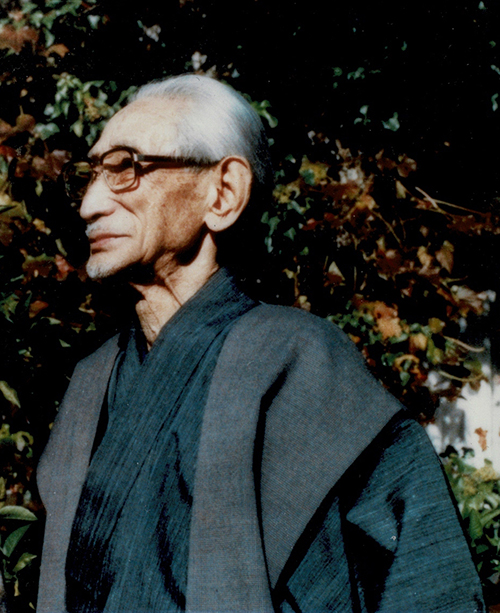
Description
Description
Katsuhei Toyoguchi was a leading figure in the interior design world who, at the dawn of Japanese design, pioneered an ergonomic perspective on furniture and advocated a new, modern lifestyle suited to the Japanese.
He was born in 1905 in Kazuno, Akita Prefecture. When he was in primary school, there were no electric lights and he had to sharpen an oil lamp every day, and went to school in kimono and geta (wooden clogs). He studied for entrance exams to junior high school, but was forced to give up due to family circumstances, and went on to Akita Technical School. In 1925, he entered the design department of the Tokyo Higher School of Arts and Technology (now the Faculty of Engineering, Chiba University), which set him on the path to becoming a designer. At the same school, he studied under furniture designer Nobuo Moriya (Ki no Mesha), who died suddenly at the age of 33. He was succeeded as lecturer by the modernist architect Chikatada Kurata.
The Bauhaus was founded in 1919 and modern design developed in Europe and the USA in the 1920s and 1930s. Toyoguchi majoured in interior design under the tutelage of Kurata, and from there he became interested in the German Crafts Federation and the Bauhaus. Modern design as seen through Kurata's eyes must have seemed dazzling compared to the situation in Japan at the time. After graduation, he participated in the establishment of the experimental design group 'Keiji-Kobo' (1928-1938), which was led by Kurata and brought together students from the same school. He commuted to the Dojunkai Apartments in Daikanyama, where the group was based, and worked as a core member. It is said that Japanese product design began with Keiji-Kobo. This is because Toyoguchi and his colleagues put rationalism and functionalism into practice at a time when imitations of foreign styles were commonplace. They were quick to switch from old Japanese system of weights (Shakkanho), which was customary for furniture makers, to the world-standard metric system, and standardised easily available and inexpensive wood to design low-cost, high-quality furniture that could be produced in large quantities. For Toyoguchi, the Keiji-Kobo was a 'period of ideological formation'.
Around the same time (1928), the National Craftworks Institute was established by the Ministry of Commerce and Industry (now the National Institute of Advanced Industrial Science and Technology) in Sendai. Bruno Taut came to Japan in 1933 and Charlotte Perriand in 1940 for guidance. Toyoguchi was invited to join the institute in 1933 by the craftsman and designer Kitaro Kunii, who was also the director of the institute, and while continuing the activities of the Keiji-Kobo, he concentrated on standardising furniture, starting with research into normative prototypes for chairs under Taut. Together with Isamu Kenmochi, who belonged to the institute at the same time, he is regarded as a pioneer of modern design in Japan. He continued to explore ways to provide modern, sensible design for consumers as a civil servant until 1959, when he established the Toyoguchi Design Institute.
In his later years, he was involved in education and manufacturer consultancy, as well as designing and planning Expo '70. His footprints are truly the foundation of modern design. In this issue, we spoke to his son, Kyo Toyoguchi, who worked with him in the Toyoguchi Design Institute.
Masterpiece
Masterpiece
Design of furniture for Dependent Houses (Occupation Forces family housing) (1945-48); The semi-resting chair, commonly known as 'Toyo-san's Chair', Tendo Mokko (1955); Interior design for JAL Douglas "DC-8", Art Director (1958); Exhibition design of the Japan Industrial Cruising Fair Ship "Sakura Maru", Japan Industrial Cruising Fair Association (1962-1963); "Spoke Chair", Tendo Mokko (1963); "Olympus Auto" 35mm camera, Olympus Optical Industries (1963); Basic design for exhibition and refurbishment of the Museum of Posts and Telecommunications, Nippon Telegraph and Telephone Public Corporation (1965)
Development and design of the "AH" all-purpose microscope, Olympus Optical Industries (1965); "Rattan Easy Chair", Yamakawa Rattan (1965); Furniture design for the entire Machinery Promotion Hall (1966); Mass-produced furniture, Necos Industries (1967); Display design for the Japanese Pavilion at the Montreal World's Fair, JETRO (1967); The 15th Tokyo Motor Show General Planning Theme Zone, Automobile Industry Promotion Association (1968); Car ferry interior, Kanematsu Shipbuilding (1971); Nakano Sun Plaza Interior Planning Basic Design, Employment Promotion Agency (1972).
Books
"The Knowledge of Contemporary Furniture Making", Togakusha (1936); "New Housing and Furniture", Technical Data Publication Society (1948); "Industrial Design: Production Engineering Course", Nikkan Kogyo Shimbun (1959); "Industrial Design Complete Collection 2", Giho-do (1963); "Design Tactics: Midsize Business and Industrial Design (Chuken Kigyo to Kogyo Dezain), Diamond (1965);" Encyclopaedia of Interior Design", Rikogakusha Publishing (1972); "From the Keiji-Kobo Studio: Katsuhei Toyoguchi and the Half Century of Design (Keiji-Kobo kara: Toyoguchi Katsuhei to Dezain no Hanseiki), Bijutsu Shuppan-sha (1987).

Interview
Interview
Design as national policy feels destined not to lead to creation
Keiji-Kobo and Bruno Taut
ー Katsuhei Toyoguchi spent more than 50 years as a designer, working on a wide range of projects, from furniture to Olympus cameras and microscopes, designing for Expo '70 and teaching design at universities. He wrote Kappei on his signature on his illustrations and other works, and his close associates also called him that, but here we will refer to him by his real name, Katsuhei. After graduating from Chiba University, the same university as your father, you worked for Matsushita Electric Industrial Company before joining the Toyoguchi Design Institute in 1963, where you worked together with your father. You actually saw him up close and personal, so in a nutshell, what kind of designer was he?
Kyo Toyoguchi When I think about it again, it's difficult. But what I can say is that he was a pioneer in modernising Japanese life. From the pre-war period to the post-war period, when many difficulties awaited us, he kept on saying that he wanted to change Japanese people's lives to a modern one all at once. The Japanese have shorter legs than Westerners. He believed that this was due to the fact that they sat on the floor, which compressed their legs and prevented them from growing taller. So he first proposed a chair lifestyle, using chairs even on tatami mats. He was proud of being a lifestyle designer. I never directly discussed this modern lifestyle with my father, but he published many articles in magazines, newspapers and books, including "Craft News", and had more than a thousand manuscripts on hand. In his later years, he selected 800 of these and compiled them into a book, "Keiji-Kobo kara Toyoguchi Katsuhei to Dezain no Hanseiki" (1987, Bijutsu Shuppansha). So, as he says in the book, it was a difficult task to keep talking about modernisation and to have actually done it, and it is not an easy task.
ー Katsuhei did not work at home, did him?
Toyoguchi At home, he wrote manuscripts and drew pictures, but he never worked. When I was in junior high school, I didn't know exactly what my father did. When I was old enough to think about applying to university, I told my mother that I wanted to study literature because I wanted to do children's literature. My mother, Fumiko, was also a poet and a graduate in literature, but she wanted me to choose a career that would enable me to earn my living, considering my future. I was worried, so I consulted my father's teacher at the Tokyo Higher School of Arts and Technology, Mr Chikatada Kurata, with whom I worked at the Keiji-Kobo. He is also my godfather. He said, "Do you know what your father is doing? Don't you want to follow in his footsteps? I think it is important". Encouraged by his words, I decided to apply to the Faculty of Engineering at Chiba University, where my father had attended.
ー Mr Kurata was a modernist architect. Keiji-Kobo was formed around Mr Kurata by a group of students who had graduated from the Tokyo Higher School of Arts and Technology. It was a pioneering group of designers who, with an eye on design movements such as Bauhaus, worked on designs, prototypes and presentations to standardise furniture and enable mass production, in response to the lifestyle improvement movement that was spreading in Japan. Their base was the Dojunkai Apartments in Daikanyama. They produced furniture while analysing it scientifically. Later, while continuing his research at the keiji-Kobo, Katsuhei joined the the National Craftworks Institute, which was established in Sendai within the jurisdiction of Ministry of Industry and Commerce. It was Japan's first design administrative organisation, and Bruno Taut visited Japan to receive its guidance.
Toyoguchi It was set up with the aim of exporting Japanese crafts to the rest of the world. Taut, an architect and urban planner who had defected from Nazi Germany, came to Japan as an instructor in modern design for this purpose. My father called the period of the Instructor's Office the 'research period'. He said that Taut taught him the essence of 'what manufacturing is' and 'the right way to design'. Soon after, he was assigned to Tokyo, and although he did not have many opportunities to receive direct instruction from Taut, he still gained valuable experience, such as studying the "normative prototype of the chair", which was of great use to him. At the same time, the institute was conducting a series of experimental measurements using test chairs in order to propose a chair that would suit the body shape, behaviour and lifestyle of the Japanese people. However, Taut rejected such scientific experimental data as useless, saying that it was all about sitting directly on the chair, feeling and sensing it.
From experiments with snow moulds to "Toyo-san's Chair".
ー The West has a long history of chairs, but in Japan there is no such sensory accumulation. The way of life is also different, so there must have been differences of opinion. What kind of experiments were conducted?
Toyoguchi They built a functional laboratory and measured data on how the height, depth and tilt angle of the support surface should be when a Japanese person sits on a chair to support the body. How did they make a mould of the chair when a person sit in it? They didn't have 3D printers like we do nowadays. Plaster and sand were difficult to use because they were not viscous and coagulable plastic media, and it was very difficult to make a mould. So, with the help of Isamu Kenmochi, my father went to Naruko Hot Springs in the middle of winter to conduct an experiment on the support surface of chairs using snow moulds. He measured the sitting posture with the snow mould and completed a human body curve diagram. He grew up in Akita, where it snows a lot, and he used to make face moulds in the snow, which gave him a hint. He lived at home on tatami mats, but he used to place a chair on them and never sat on them. My father liked kimonos, so he used to wear them and sit on a chair on the tatami.
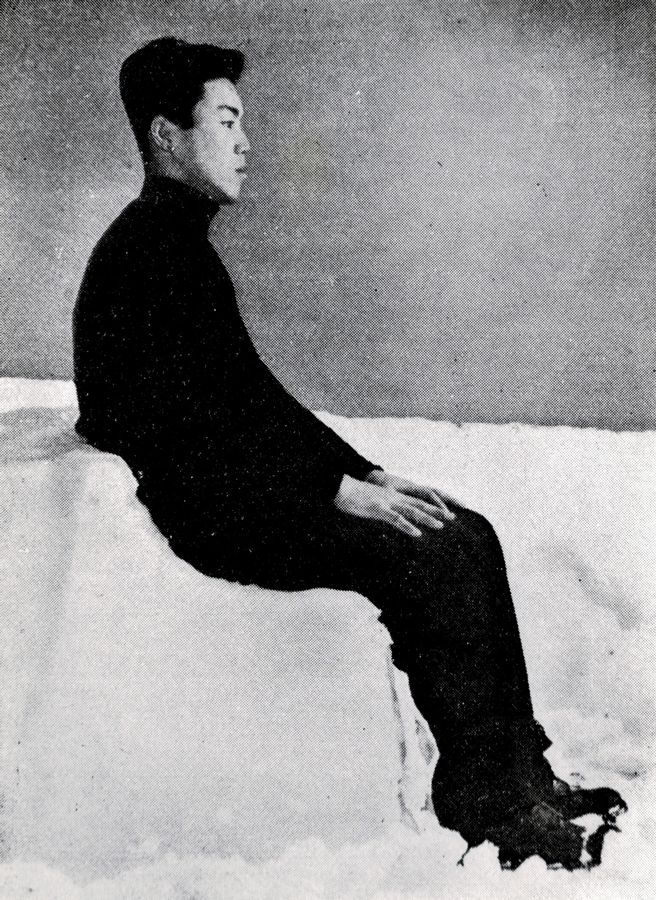

Left/Measurements using snow moulds made at IAI.
Right/A sitting measurement device was developed and functional experiments were studied.
ー The semi-resting chair named 'Toyo-san's Chair' by Yoshio Akioka in 1955, the "Spoke Chair" in 1962 and the "Rattan Resting Chair " in 1965 have seat heights of less than 40 cm and are not found in any other country. These are chairs that do not exist in other countries. They can be placed on tatami mats without looking down on those sitting on them, and can be used to talk without concern. The design is in keeping with the new post-war lifestyle in Japan, where Japan and the West are mixed together. The 'Toyo-san's Chair' was developed through years of experimentation, observation of human behaviour and measurements of the seat and back, even before the term "ergonomics" had taken root. It can be said that the chair combines the theory of Western chairs with the best aspects of Japanese chairs.
Toyoguchi Each chair retains the Japanese way of thinking about sitting, such as the "Spoke Chair", which allows the user to sit in a relaxed position on the seat. You can change your position in any way you like. Chairs that allow you to flop over, sink deep or lean on the armrests do not allow you to move on to the next action as soon as you sit down. The inclination of the seat and the angle of the back are reduced so that the chair can be used for work.
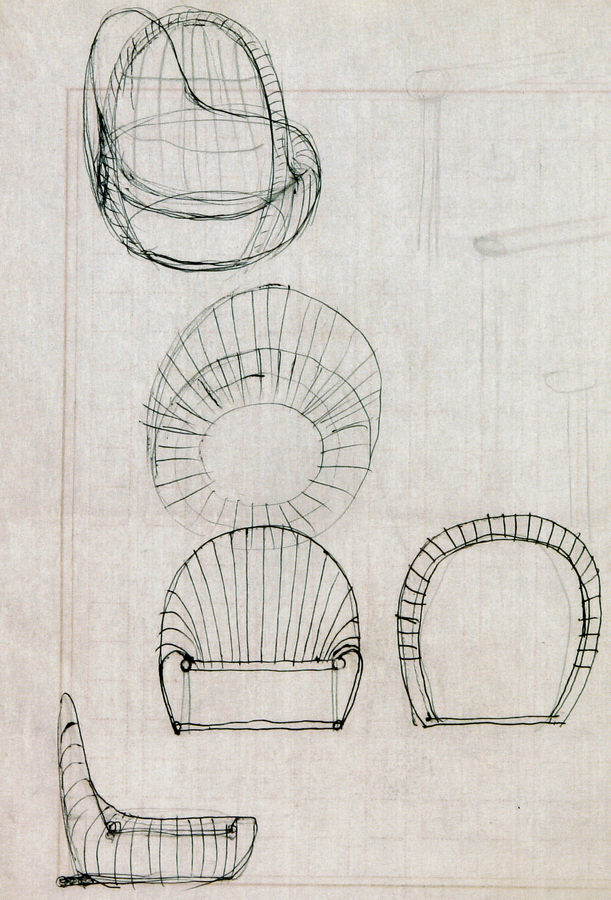
Sketch of "Rattan Resting Chair". He wrote on manuscript paper or on the back of used paper.
ー Even the cubic curve, size and filling found in the seat surface and other parts of the chair are based on experimental data from research. I understand that the research was then taken over by Jiro Kohara's laboratory at Chiba University.
Toyoguchi The Ministry of Commerce and Industry worked on the standardisation of daily necessities and at the same time promoted the standardisation of furniture. The results of this work led to the establishment of JIS (Japanese Industrial Standards). He also conducted thorough research on ergonomics anyway. But I had a discussion with my father in his later years. Ergonomics, as practised by my father, is about capturing human dimensions. But that is not an area that can be called engineering. He said that we should look at the relationship between tools and people from the perspective of human behaviour, from the viewpoint of what kind of dimensions are best, and what kind of psychology and behaviour people would have at that time. You sit down in a chair, suddenly want to drink a whisky, and get up to get it. Why do people change their minds from sitting down to standing up? I suggested that research should be done into human psychology and behaviour. In short, I said that ergonomics is old-fashioned. To which my father replied, "You do it" (laughs).
Furniture industry as a national policy
ー In 1952, the National Craftworks Institutes was renamed the National Industrial Arts Institute of the Ministry of Commerce and Industry (IAI). Katsuhei was head of the design department there.
Toyoguchi At IAI, after the war, he was ordered by GHQ to design furniture for the Dependent Houses (Occupation Forces family housing). I hear that was the most difficult part of the project. When Washington Heights, a US military facility, was built in Yoyogi for US military families to live in, the furniture had to be designed anew. The physique is different from the Japanese and the height of the chairs is also different. The government organisation designed the furniture, which was then used to make furniture in Japan. This led to the growth of the Japanese furniture industry, which was another policy of the then Ministry of International Trade and Industry. During the war, there was no such thing as design. After the war, design was introduced as the key to such lifestyle culture.
ー Katsuhei was responsible for this, and he also asked Yoshio Akioka to take on the task.
Toyoguchi At the time, the standard of furniture in the USA was not necessarily high, but inspections by US Army colonels were strict, and they required orderly, uniform and modern furniture and equipment. We are told that these were produced in hundreds of factories across the country. This work gave them a sense of a revival of craft work that had seemingly ceased due to the war. However, he suffered from pulmonary tuberculosis as a result of so much hard work. He underwent major surgery, removing seven ribs and losing one lung, and after three years in hospital he returned to work.
ー While experiencing such a serious illness, he then went on to teach design at university and also worked as a director of Japan Airlines.
Toyoguchi When Japan Airlines purchased the Douglas DC-8 aircraft, he travelled to Douglas Aircraft Company in the USA and explained to them what Japanese interiors were like, and had them create the aircraft's interior as art director. In the US at the time, they were selling Japanese things in Chinatown, so it was very difficult for him because there was a different 'Japonica' permeating the US than what Japanese people thought.
ー Big projects were going on. He also designed the exhibition for the Japanese industrial cruise fair ship "Sakura Maru" and was an advisor to the Osaka World Exposition Association display design. He has also been active in many fields, including chairing the Japan Industrial Designers Association (JIDA) and founding and inaugurating the Japan Association of Interior Designers (now the Japan Interior Designers Association, JID).
Toyoguchi My mother (Mrs Fumiko) gave him the gift of "this slimming, one-lung flight with seven ribs removed" because of the way he looked.
The Montreal Expo, which was controversial
ー I was struck by a sentence from Katsuhei's book in the aforementioned "Keiji-Kobo kara". It says: "Japan awoke to design research and research guidance very early, but there is a big difference in that it did not occur as the action of a group of oppositional spirits like the Bauhaus, but was linked to industrial development and export promotion as national policy, and one cannot help feeling that it was destined not to lead to creation". Yoshio Akioka describes IAI as "a graduate school of design that does not require monthly fees", and I thought that he felt the limits of design policy under the guidance of government agencies, even in a place of cutting-edge practice where excellent human resources were gathered.
He retired from the Ministry of International Trade and Industry (MITI) in 1959, first renting a separate room in Yoshio Akioka's office and starting the following year as the Toyoguchi Design Institute. Mr Kyo joined the institute in 1963. We will ask you about your footprints again, but first of all, please tell us about your common projects.
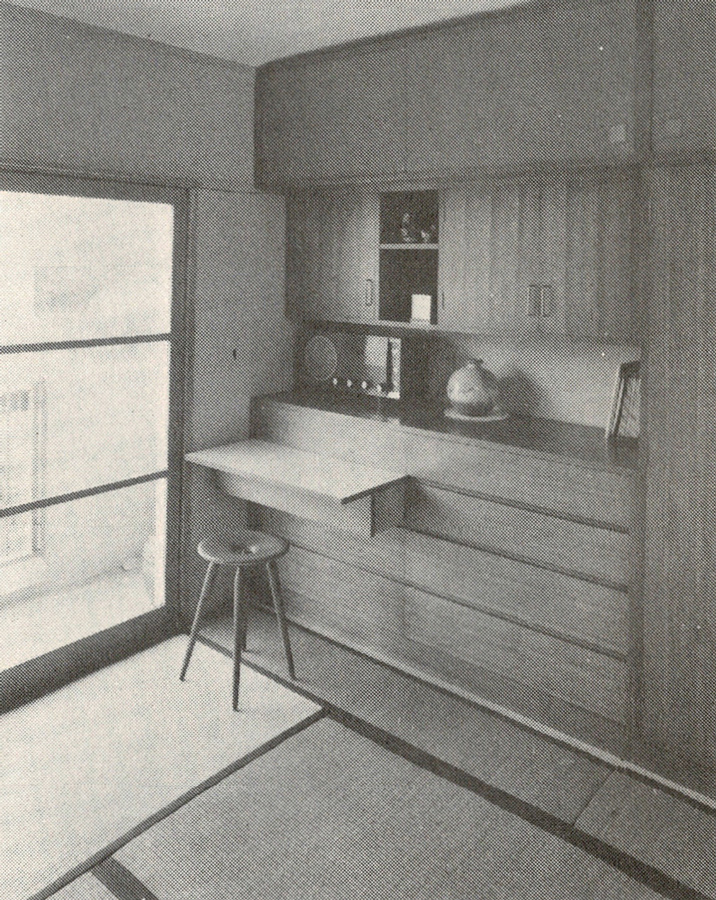
In 1959, after retiring from IAI, he bought a council flat with the intention of setting up his own business. He designed storage unit furniture to co-exist with the tatami mats.
Toyoguchi We worked together on a lot of Expo '70 projects. We also did the cruise fair "Sakura Maru" and Nakano Sun Plaza together. I left my previous job to help build a design school, and I wanted to do something original while being named as a member of the institute at that time, and my father had clearly told me that he had no intention of me following in his footsteps. When I actually started working with him, the work was tough. It was so strict that when I came back from business trips abroad, I was forced to go directly to work instead of returning home. My father told me that "Designers need to be trusted by people. Especially in the future, trust will be very important", I remember being told. Also, "never be late for an appointment" and "don't speak ill of others". This is another lesson my father used to tell me.
ー Since you mentioned Expo '67, I would like to ask you about the 1967 Montreal World's Fair. The display of the Japanese Pavilion was controversial, and in terms of his work, he looked back on his illness and the criticism of the Japanese Pavilion as the most devastating event.
Toyoguchi We took part in the exhibition planning by cooperating with the Yoshinobu Ashihara Architect and Associates. It was a wonderful design, in the architectural style of a schoolhouse but with a modern design, but the budget ran out and the exhibition project was scrapped. So we put together a plan on a modest budget, raising additional funds. We bowed down to the manufacturers and asked them to provide us with the equipment they had, which we used for the exhibition, but they criticised us, saying that this was not a trade fair and that it was embarrassing. My father was alone and worried.
ー The book "Keiji-Kobo kara" also includes a full account of how it all happened. The book includes a chapter entitled "Montreal Expo and Afterwards", which also includes the evaluations of the event in the newspapers and magazines of the time. He stated his opinion in the book that "the government's administrative attitude, policies and goals should be clearly set out for such an international event". This is an issue that we still face today, and the designers and others involved continue to be cornered. This book is very important as an archive. What else is in his archive?
Toyoguchi In terms of archives, the chair and drawings from the Keiji-Kobo and the old research that led to JIS have been donated to the Matsudo City Board of Education in Chiba Prefecture.
ー The chair is a valuable original. 'Toyo-san's Chair' was manufactured by Tendo Mokko and used as a chair in the reception room of the Akita Prefectural Government. Later, in 1983, Yoshio Akioka reissued the chairs at "monomono", where they are still sold today. When Katsuhei retired from Musashino Art University, the museum and library asked him to compile a bibliography, which he submitted to the university. Reproductions of the Keiji-Kobo chair and "Toyo'-san's Chair" are now in the Musashino Art University's museum and library collection.
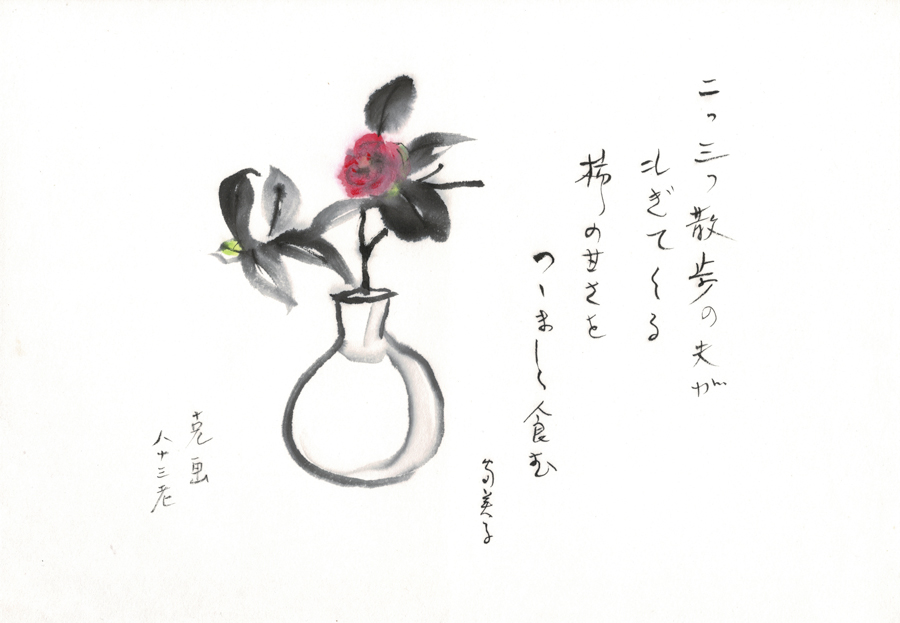
He left his work to his successor after the age of 70 and enjoyed painting in his later years. Together with Mrs Fumiko's tanka poems.
Enquiry:
Matsudo City Board of Education, Cultural Property Preservation and Utilisation Section, Museum Preparation Office
4-63-5 Minami Hanashima, Matsudo-shi, Matsudo, Chiba 271-0065
Musashino Art University Museum & Library
https://mauml.musabi.ac.jp
1-736 Ogawa-cho, Kodaira, Tokyo 187-8505
Tel: 042-342-6004
Fax: 042-342-6451

